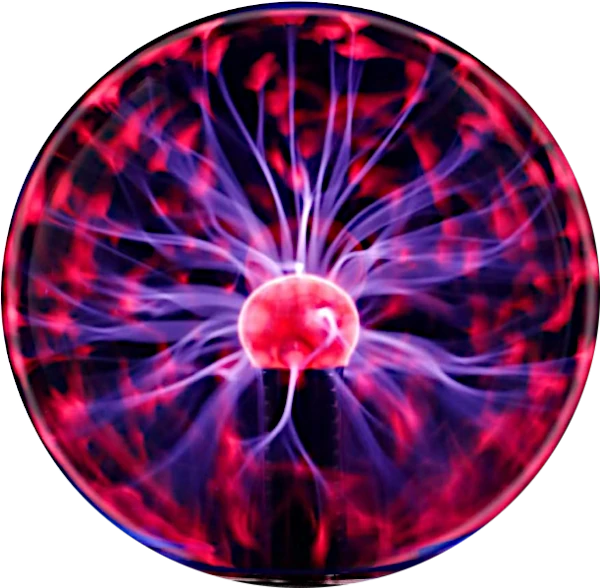
Image Description: In a plasma lamp, the image of a field appears. The electrical arcs we observe somewhat follow the field's lines of force, giving the illusion of a filament structure. The electrical arcs are a manifestation of this field, but they are not the field itself. What we see are the effects of the electric field on the ionized gas.
The plasma lamp, easily found on the Internet, is a device that creates spectacular visual effects. But beyond the light show, one can glimpse the fascinating concept of a "field," making the plasma lamp a veritable miniature physics lab.
Plasma is the fourth state of matter where atoms are ionized, meaning electrons are separated from atomic nuclei, creating ions and free electrons. This typically occurs at high temperatures or in the presence of an intense electric field.
In a plasma lamp, a noble gas (such as neon, xenon, argon, or krypton) is typically used. Although noble gases strongly resist forming chemical bonds (since the outermost electron shell is saturated), they are chosen for their ability to ionize easily under the influence of an electric field.
Inside the plasma lamp, there is a rare gas under low pressure, subjected to high voltage generated by a central electrode. The voltage applied to the central electrode usually ranges between 2 kV and 20 kV, depending on the lamp's design and size. This high voltage ionizes the gas atoms and influences the plasma's behavior by altering its electrical, thermal, and dynamic properties, particularly its intensity and color. The glass lamp is usually spherical to allow for uniform plasma distribution.
When voltage is applied to the central electrode, an electric field of several kilovolts is created between this electrode and the glass sphere's walls. The intense electric field ionizes the gas atoms, creating ions and free electrons. The electrons are then attracted to the central electrode, creating a visible electron flow through the luminous filaments. The ionized areas create conductive paths for the electric current, allowing plasma filaments to form and move through the gas. These filaments often appear as lightning or plasma arcs moving outward from the central electrode.
The colors of the plasma filaments depend on the type of noble gas used. Neon produces a red-orange light, argon produces a violet light, krypton produces a blue light, while xenon produces a blue-violet light.
N.B.: The color of the emitted light depends on the energy difference between the electron energy levels of the atom. When an electron "jumps" from a higher energy level to a lower one, it emits a light photon whose energy corresponds exactly to the energy difference between the two levels. This energy translates into a specific color.
The image offered by a plasma lamp, with its luminous filaments that seem to dance in all directions, evokes the idea of a field, as if the filaments follow lines of force.
The electric field is a general concept that describes the influence of charges on the surrounding space. It can be represented by field lines that indicate the direction of the force a positive charge would exert if placed at a given point. These field lines are radially oriented from the central electrode.
The central electrode creates an intense electric field that extends throughout the lamp's volume. Plasma, being an excellent electrical conductor, allows charged particles to move freely. However, electric fields superimpose. This means the total electric field at a point is the vector sum of the electric fields created by all present charges. The superposition of electric fields, plasma instability, and interactions between charged particles explain the non-linearity of the filaments and their irregular shapes.
The image we perceive of the lamp is dynamic because the charges are constantly moving, following the fluctuations of the electric field. Thus, the luminous filaments follow the electric field lines, providing a direct visualization of the field's configuration.
Each point in space within the lamp is subject to an electric force with a precise direction. This direction is tangent to the field line passing through that point, which can be interpreted as a vector. Indeed, the electric field is a vector field, meaning a physical quantity (a vector) is associated with each point in space.
This visualization is a simplification of reality because plasma is a complex medium where numerous physical phenomena interact. Nevertheless, the plasma lamp offers a simple and elegant way to represent the concept of a vector field.
To read the full article, click here.